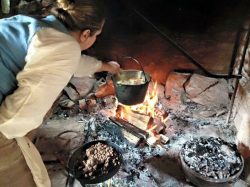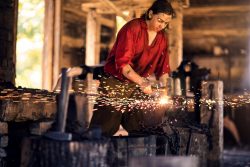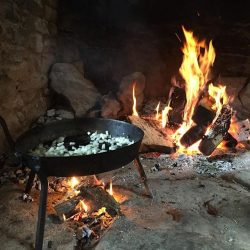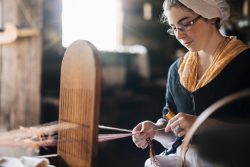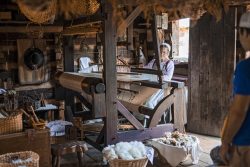Up Close and Personal: Pricketts Fort
May 8, 2018In this blog series, Up, Close and Personal, we’re going to answer some of – what I’m sure are- your most burning questions about places in Marion. The first blog of the series focused on me and Leisha (also known as the CVB, also known as the Visitors Center). And in this blog, we’ll be taking an up, close and personal look at Pricketts Fort – more specifically, the living history interpreters.
Judy Wilson is a living history interpreter at Pricketts Fort with a strict motto, “Living history is not theatre.”
She’s been there for 28 years, so she knows what she’s talking about. What her motto means is pretty simple: everything is real.
“We don’t unweave what they saw us do, and then weave it again for the next guest. And we do these things whether anybody’s here or not. … Everything here is real. If it looks hot, it is. If it looks sharp, it is,” she said.
All the goods produced – tomahawks, axes, bracelets, shawls, textiles, baskets, hats and hooks – are either used in the fort or sold at the trading post.
You can take a behind the scenes look at just what all goes into producing those textiles. Sheep to Shawl is an event held each year that takes a look at the process of shearing the sheep to carding, spinning and weaving it into something wonderful.
The five living history interpreters employed by the Pricketts Fort Memorial Foundation work together doing everyday activities that 18th-century fort residents would have done.
Cordelia Spencer cooks only 18th-century recipes on the hearth and Israel Rollison blacksmiths 18th-century tools and necessities.
“I never have a bad feeling after I finish something and I get to look at it, like this ax. That brings me so much happiness…,” Israel said.
Israel started in blacksmithing as a hobby, eventually taking the blacksmith classes at Prickett’s Fort.
“Basically, I did well enough at the classes and I just kept coming around,’ he said of how he was offered the interpreter position. “The blacksmithing and the atmosphere itself, it’s amazing to work here.”
He said he has become absolutely addicted to the craft and still blacksmiths at home.
“As a hobby, it didn’t start off historically-oriented. I loved the fact that I could make every single tool that I needed to make other tools and other things. So that’s what really got me started,” he said, adding that all of his goal are now historically-oriented. “I love interpreting it. There’s so much depth to what they did.”
Cordelia’s story is a bit different. She volunteered at the fort, worked in the visitor center for three years and then became an interpreter.
“I said when I started it that I would be here until it became a job. And when it became a job, I was quitting,” she said. That was 11 years ago.
The 18th-century skill she loves most is hearth cooking, which is a lot of trial and error. Right now, she’s working on making a boiled pudding within a stew, cooking two dishes at once. Other dishes she makes include pork and apple pie and a squash dish.
“I can’t do pizza over there because I know it’s not period correct. So I’ve got to be able to find the recipes that they would have used when they would have been cooking. And to know, to be able to back up my information…,” she added.
However, she said the taste of some of the things she makes are so different that she can’t describe it. For example, she said there is nothing that we have now that tastes like cheese woodchuck that would help someone to understand what it is.
“It’s just fun. It’s interesting. It’s different. It’s exciting to find the things they did differently and the things they did the same. And I love history. It’s just fascinating to think that this is the way they lived,” she said.
(For a more recent history, the Job Prickett House jumps 80 years into the future, making it a 19th-century farmhouse. It is decorated and equipped with all things from that era.)
“There are many days we’ve spent huddled around the fire,” said Katie Donnelly, a living history interpreter for two years now.
“We dress the way that they would have dressed and so we do the layering thing,” she said, adding that they try to stay as true to the period as they can.
However, there is a balance to be found in living accurately and living safely.
“Most 18th century women wouldn’t have worn glasses. Well, I’m going to run into something if I don’t wear glasses,” she said and laughed.
The newest member of the team is living history interpreter Sarah Blosser. After graduating with a degree in history, she said she wanted the chance to experience the 18th century and see what it was like.
“I think it’s better to be able to live it because then you really understand that it was hard. And I mean, you can learn about it all day that it was difficult for them to do all these things, but until you actually experience it – you couldn’t just go out and buy things. You had to make it and make everything work,” she explained.
Unlike the living history veterans, Sarah said her 18th-century life hasn’t yet affected her 21st-century life.
“Oddly enough, I do prefer cooking all my food over a fire when I can. That’s because I get the taste of it here,” Israel said. “ You get the smoke in it and everything; it’s so good.”
Before working at Pricketts Fort, he said he would just throw stuff in a pan and see what happened.
“I, on the other hand, appreciate my microwave more,” Cordelia said and laughed. However, she said she’d like to get a fireplace on her patio to be able to cook 18th-century style at home.
For Judy, 18th century life was part of many decades prior to coming to the fort.
“When we’re taken on board, it’s very handy if we already have some of these skills. When I came here, I had been spinning and weaving for decades. So that made me a real handy hire, and I’m a retired classroom teacher,” she said.
Spinning was something she had wanted to do from childhood.
“Not just spinning and weaving, but living simply. I grew up in upper-middle-class suburbia and was grateful for the many advantages, but I knew it wasn’t for me from the time I was a child,” she added.
Katie said she has a loom at home and is setting up a spinning wheel.
“I’ve definitely started thinking, ‘OK, we need to plant a garden,” Katie said, adding that she still lives a fairly normal life at home.
For all five of them, the 21st-century amenities are essential to their 18th century work. They’re all actively researching new discoveries of what life was like to make their interpretations more accurate.
“The thing with history is (that) it’s not necessarily cut and dry. You know, we’re always finding new ways to interpret what happened. We’re always finding new information,” Katie said. “People always think of history as ‘It happened. It’s done. We know everything there is to know.’ But we don’t.”
What would you miss most about modern day life?


